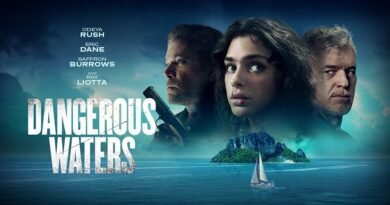“Mickey’s Mouse Trap”: A Cinematic Mouse Crap, Or A Funny Bad Film? | Review
The writing was on the wall, so it’s hard to say that the mountain gave birth to a mouse. You couldn’t expect too much from a Mickey Mouse horror movie, or should we say Steamboat Willie, the first version of Mickey Mouse from 1928. But from the moment the copyright expired on the old character, it was clear that making a horror movie about the world-famous mouse was a race against time – especially considering the tremendous and unjustified success of that Winnie the Pooh horror movie. A few days after the rights expired, we were already informed about several movies, some of which look (relatively!) promising on paper and others like a piece of cinematic crap, trying to ride on the character that has become a household name and make some decent money, before we forget, or even someone who would win the race and make the “First Mickey Mouse Horror Movie.”
So the first Mickey Mouse horror movie, which is already available for home viewing, is “Mickey’s Mouse Trap” (also known as “The Mouse Trap”). I was expecting the worst, making jokes about “Mickey’s Mouse Crap” even before I started watching. So I went to watch it out of pure masochism, a service of informing the public to avoid it at all costs. But there was another reason: the hope that the movie would be so bad that it would be funny, as sometimes happens in our favorite genre. Something like an hour and twenty later, not including a few intentional breaks I took to figure out if I saw what I thought I saw correctly, I came back with my conclusions.
Spoiler alert: This “Mickey’s Mouse Trap” review may contain terms I made up to find the words to describe it, like “cinematic mousetrap” or “pure rat poison.” Still, I found some good stuff here, perhaps because I’m naturally optimistic.
Let’s start with “Mickey’s Mouse Trap” trailer:
Have Some Killer Celebration With Mickey
My expectations from “Mickey Mouse Trap” were low as hell. Not only because it’s a movie about a murderer in a Mickey Mouse mask, but because I knew in advance that it was stabbed by anyone who watched it and survived to tell the guys. You can’t expect too much from a movie based on the poor reviews and the current user rating on the world’s biggest movie website (IMDB), which is 2.5 out of 10. The meaning is you can expect something on the level of the fourth Jeepers Creepers movie, the very amateurish first Winnie the Pooh movie, and a few other works that I’ve already forgotten I’ve seen, such as the terrible adaptation of the computer game “House of the Dead.”
The plot of “Mickey’s Mouse Trap” is simple: young people arrive at an amusement arcade to celebrate Alex’s (Sophie McIntosh) 21st birthday. Very quickly, after some strange dialogue and unclear dynamics, a serial killer dressed as Mickey Mouse begins murdering them one by one. From this description, you might expect a guilty pleasure or the beloved subgenre of “horror movie so bad you can’t stop laughing at it.”
Unfortunately, “Mickey’s Mousetrap” usually doesn’t meet this simple requirement.
The film begins in a strange but plausible manner, with a caption that addresses the issue of copyright and fear of Disney, which is known to be very jealous of its products. In the first scenes, we discover the main character, her shiftmate, and the boss (Simon Phillips), a Mickey Mouse enthusiast, who has an epiphany in which someone who sounds like Mickey Mouse speaks to him and encourages him to get into a costume and do terrible things.
I dwell on this scene because it is essentially the only time in the film that we can understand who is behind the murders. The film reveals it even in the credits, so actually, the IMDB cast list is a possible spoiler of something that doesn’t get a proper explanation in the film.
The film chooses to ignore this issue consciously. Including the characters, who are sure that there is someone else behind the murders, even though it is clear to us and at a certain point to them that it cannot be that guy. In other words, the essential tension regarding the killer’s character, perhaps the main characteristic that can make slasher films with a masked killer plausible and fun, is not present here.
Alongside all those puzzling scenes at the amusement arcade, or whatever that place is, a large portion of the film’s screen time is devoted to police interrogation of someone who is presented as one of the only survivors: the goth and possibly lesbian girl Rebecca (Mackenzie Mills, who does a decent job). She is interrogated by two cops, one supposed to be the good cop (Damir Kovic).
The other is, of course, the bad cop (Nick Biskupek, with a resume of several psychopathic characters in low-budget films by the same filmmakers, such as horror films about a murderous Santa Claus. I kinds like this guy). This definition mostly amounts to repeated looks of contempt and denial of everything the suspect says because that’s what bad cops are supposed to do in movies.
The main problem is that these scenes contribute very little to the film. We only discover a little new, not about the characters or the dynamics between them. The impression is that they are mainly here to fill some time, and most of them could have easily been gotten rid of.
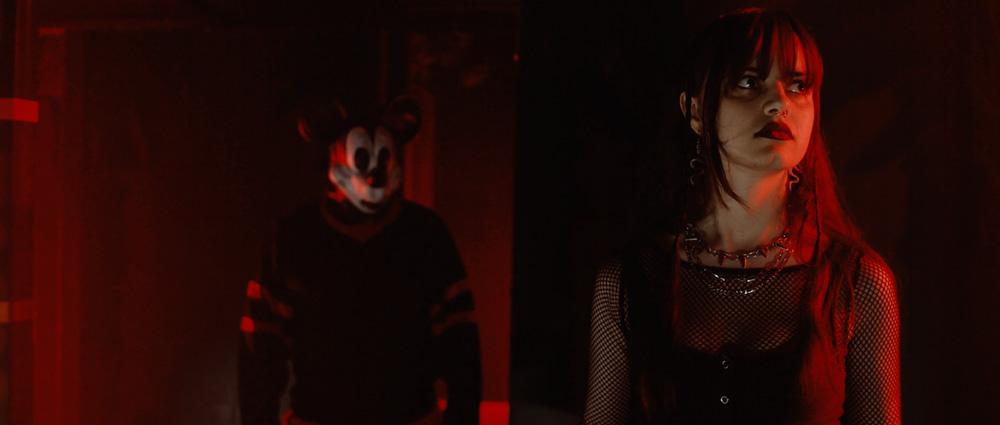
Mickey’s Mouse Trap Review: No Plot, No Suspense, No Characters
So we’ve seen little (or any) plot suspense here. This makes sense considering the plot description and the fact that we’re talking about “Mickey Mouse’s Mousetrap,” and not – just a random name – Agatha Christie’s “The Mousetrap,” the famous detective play that has been performed in London since 1952 to this day (!), known for a twist that viewers were asked not to reveal. So, expecting Agatha Christie or a surprising slasher is a bit excessive, but a better script was needed.
The good news is that the film has some positive points. The cinematography is reasonable considering the budget, even if some scenes are too dark or with exaggerated shades of red or blue. The location does the job in most cases; there are some amusing sentences in the script, and the film has a particular nostalgic dimension, and it is not too long. In addition, mice are fascinating animals, cheese is delicious, and being at Gymboree with children can be fun. Having a birthday at Gymboree can also be a good choice, especially at relatively young ages, when the children can play a little on the rides and give the parents some time to rest and talk to each other.
The bad news is that I had difficulty finding many good things to write about the film, so we’ll have to stick with these lines for now. In other aspects, the picture could be so much more optimistic. Someone wise once said that there’s only free cheese in a mousetrap, and that’s true to a certain extent in this film.
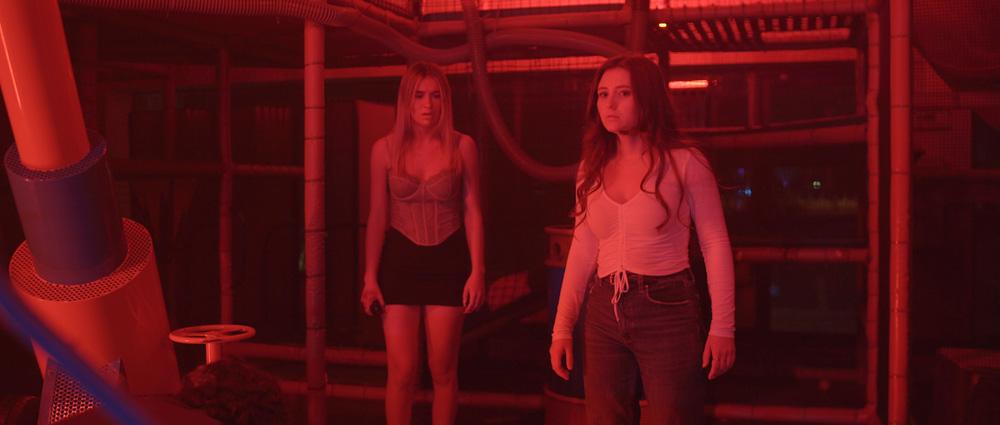
The Cast Of Mickey’s Mouse Trap: Only A Few Were Good
In terms of the acting, characters, or dialogue, it’s hard to expect too much because we know in advance what the film is about and the minimal budget, and don’t really know the cast. We get a representation of most of the stereotypes familiar from films of this type – you know, the final girl (who, at least here, isn’t final), the shy nerd who’s secretly in love with her, the dushbag athlete who’s aggressively in love, the sexually extroverted blonde (to her credit, she included a rather amusing cynical dimension), the goth girl (she was also cynical because horror goth characters are almost always cynical), and so on.
The problem is that the film took this dull representation a few steps further. We can reduce the characters to one specific stereotype, a single facial expression that expresses it, and a monotonous tone that is also supposed to complete the character. Most of the characters made silly decisions time after time, but you can’t expect much in a horror movie.
Some of the cast does a decent job, sometimes delivering funny sentences. The lead actresses did their job, mainly Mackenzie Mills and Sophie McIntosh in the leading roles, even though they didn’t have much to work with.
In other cases, you must go through many tedious and unclear scenes with exaggerated acting to get to them. Without mentioning names, some actors and actresses read their sentences monotonously, or as one would expect from their fundamental characterization, regardless of the content or what is happening in the scene. The result is wildly exaggerated overacting without the characters’ development, progression, or emotion. Not to mention the lack of chemistry, even between characters that are supposed to be friends or secretly in love.
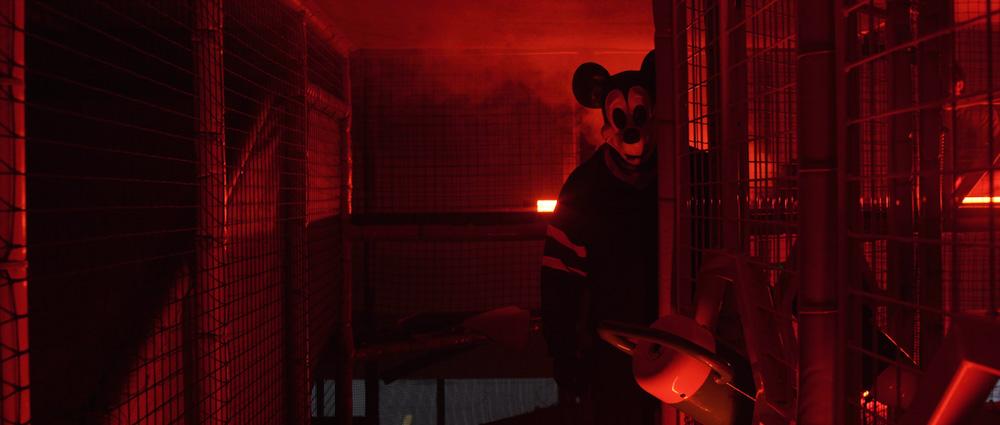
What The Hell Happened To Mickey Mouse?
I am a forgiving person by nature. I believe that even a bad horror movie can be enjoyable without high levels of acting, characters, script, or tension. I had such expectations in this case as well, but they quickly disappeared.
Mickey Mouse appears in the frame in a way that looks like it came out of the factory of low-budget horror clichés. His costume is reasonable, and we can forget the weird laughter that rolls around. The problem is that Mickey’s character is unclear from a narrative perspective. I remember, for example, a sequence of three or four consecutive scenes, in each of which a different character encounters Mickey, without any interesting development in the scenes or anything happening between them. That way, you don’t create tension or interest and don’t build a plot with logic – Unless Mickey Mouse can launch himself from place to place for no apparent reason.
Oh, damn. Oops.
In “The Mouse Trap,” Mickey Mouse believes that a serial killer in slasher films should wave his knife or carve glass with it. For some reason, he does almost every time the camera is on him, maybe because these images are supposed to scare us or make him look creepy, I guess. At some point, as someone who finished film studies and learned all about phallus symbols, I was afraid the knife was going to have sex with something.
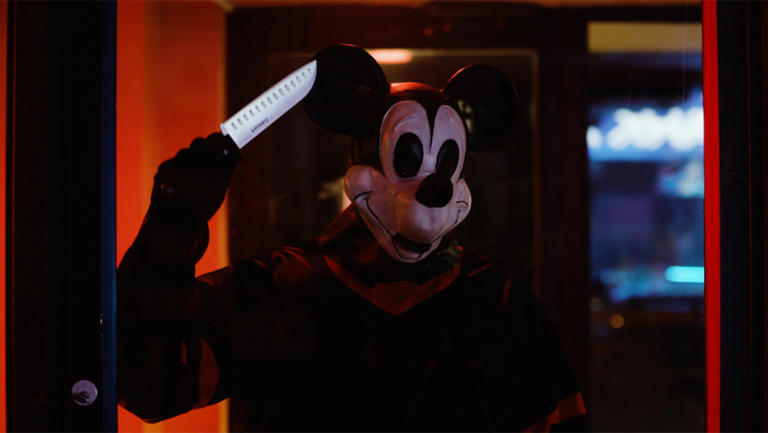
When Mickey is not doing some weird things with the knife, he’s wiping himself behind the characters, usually with a worn-out sound effect. There are supernatural elements to his character, such as the right to replicate himself to another location (huh?) or to harm characters with the help of telepathy (what?). The film, sadly, doesn’t try to explain why and wherefore. Such plot holes aren’t necessarily a problem because even in the Art the Clown films, we’ve seen incomprehensible elements in the villain’s character and backstory. Some issues still need to be answered or won’t get answers, but this didn’t detract from the film’s enjoyment, especially its all-too-successful villain.
A Mickey Mouse Film, With Some Random Mask
Still, for the film to hold us, it needs to include a certain amount of logic or a narrative structure that will show some progress, and that doesn’t happen. Mickey’s only weakness seems random, and the solutions offered by the characters are strange. With a bit of research and love for the original, it would have been possible to find plot explanations from the world of Mickey Mouse and Steamboat Willie, even particularly disturbing or creative ones. You know, Mickey throws cheese at the characters, breaks into his famous dance, kills them with a hotdog, waves one of the characters’ heads like Steamboat Willie did to one of the cats, cuts off the characters’ heads with a ship’s rudder, hammers one of the characters’ teeth, and so on.
These are ridiculous suggestions, I admit. But if you watch the film, you might realize that the solutions chosen are not much better than that. If you select a stupid direction, let the movie be aware of itself and the nostalgia it’s supposed to embody.
Unfortunately, that doesn’t happen. We get the feeling that Mickey is here mainly as a gimmick to attract viewers with too much free time (damn!). Moreover, you could replace his mask with a thousand and one other characters (as long as they became common knowledge, of course!).
Mickey’s Mouse Trap Shows: Every Ending Is A New Beginning
The film ends abruptly and illogically, without us knowing what happened to some of the characters, what the villain’s backstory is, or whether the police investigation even led in a particular direction that could be relevant to the viewer and that would explain why we wasted screen time on it.
In the scene after the credits, we get a plot idea that could explain a sequel, perhaps with a few more new characters from Mickey’s arsenal. Indeed, we recently learned of a sequel in development: “The Mouse Trap: Welcome to the Mickeyverse,” in which we will also meet Minnie Mouse in what may be a new cinematic universe.
Should You Watch Mickey Mouse Trap?
So it’s true that it’s not wise to kill a film of low quality from the start; some would say it amateurish or may call it “Pure Rat Poison”. It’s easy to be cynical about films of this type, which sometimes people make to “take a shortcut” and attract an audience even without investment because horror films about beloved childhood characters can be enjoyable and attract horror fans. “Mickey Mouse’s Mousetrap” puts us in this trap and proves that the deadly reviews of it are pretty justified, even if, surprisingly, I have already seen worse horror films (which means that the criticism could be of me, and of my choice of how to spend my free time).
The sequel or other horror films of the famous mouse may save the day a little. But even if it doesn’t, Mickey Mouse is in good company, which will continue to grow in the coming years with more horror films that will ruin our childhoods. When will the Bambi and Peter Pan films arrive?
Some of the links on this site are affiliate links. That means if you purchase through them, we might earn a small commission. But don’t worry... it won’t cost you extra, and it probably won’t summon anything...
So if you’re thinking of buying something… don’t be afraid to click! 🔪👁️



